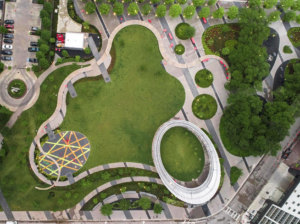This fall, Dallas’ much-anticipated Pacific Plaza will complete its transformation from a surface parking lot to a public park. The urban park, funded entirely by Downtown Dallas Parks Conservancy, broke ground in April of 2018 with the promise of introducing more green space to the city’s center. In the months since, not a detail has gone unnoticed by the world-class design, landscape and architectural firms bringing this neighborhood park to life.
Dallas-based HKS Architects is one such firm. With past projects that span the globe, from New York to New Delhi, San Francisco to Shanghai, HKS was given the opportunity to bring their expertise to the new park just outside their headquarters. SWA, the park’s lead designer, selected HKS’ LINE, or Laboratory for INtensive Exploration, team to create an innovative design for a central park amenity – the pavilion anchoring the intersection of North St. Paul Street and Pacific Avenue. This large, shade-providing structure reaches out toward the corner, wraps around the event and lawn space and ultimately create an iconic sense of place that showcases generations of architectural heritage. It will be constructed from bead-blasted stainless-steel panels, with small round holes that filter sunlight during the day and create a dappled shadow-display on the landscape below.
But this is no ordinary perforation. The visual pattern on the panels is actually an abstracted version of American Morse Code, a nod to the rich history of Pacific Avenue, Pacific Plaza’s namesake. Beginning in the late 19th century, this road was a rail line in the Texas and Pacific Railway that ran from 1871 to 1976, providing service from El Paso, Texas, to New Orleans, Louisiana. During its operation, conductors and engineers communicated by telegraph using American Morse Code to map out the tracks, train stops and elevation. Historical information related to this route, such as train stops and track elevation, was translated into American Morse Code for use as the perforation pattern for the Pacific Plaza panels.
To help bring these Morse Code patterns to life, HKS conducted numerous studies exploring spacing, hole size and expression of the pattern to get every detail just right. These studies eventually led designers to create a gradient pattern. At the lowest of point of the pavilion, the pattern will be solid stainless steel and then will slowly become more perforated toward the top.
Zahner, an internationally acclaimed architectural metal and glass company, created panel mock-ups to explore different finishes such as a mill-finish, angel-hair finish and bead blasted finish. Each option was compared against the other to determine what looked best, as well as what finish would best reduce glare. The result is sure to be a dynamic shading pattern that will not only capture how light changes throughout the day and throughout the seasons, but will serve as reminder of Downtown Dallas’ rich history.
The Morse Code pavilion panels are just one of many examples of the meticulous attention being paid to each component of Pacific Plaza, all in hopes of constructing a park that serves generations as a neighborhood-defining place of beauty, function, meaning, and connection. What Pacific Plaza feature are you most excited to see when the park is unveiled to the public? Share your thoughts with us on Facebook, Instagram and Twitter.





